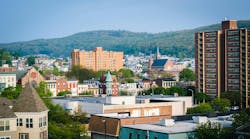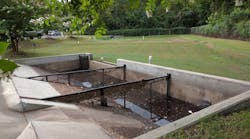When the San Francisco 49ers football team decided to build a new stadium in Santa Clara, Calif., there were many advantages to making the move. The new location had double the square footage, better freeway access and about twice as many parking spaces. But the new site had its challenges as well, one of which was managing the rainwater runoff.
The new stadium sits adjacent to San Tomas Aquino Creek, which flows into San Francisco Bay less than 6 miles away. A venue capable of seating 70,000 people requires large parking areas and other impervious grounds. During the rainy season, rainwater can turn a football field into a muddy swamp and a parking lot into a floodplain. Runoff from parking lots typically includes trash, debris and petrochemical pollutants that drip or leak from vehicles. The site is located on land with a high water table, and existing storm drain lines are shallow. As such, a storm water infiltration system would not work.
Biofiltration System
To handle storm water in the parking lots, access roads and other hardscape surrounding the stadium, project manager GHD Eng. selected the BioMod biofiltration system, a precast modular storm water collection and natural treatment system manufactured by Oldcastle Precast. The first two systems needed to be installed at the outset of the project, even before the contract for stadium construction had been awarded, which added to the overall challenge. The underground contractor had only 70 days to either install the system and tie it into an existing storm drain, or pay liquidated damages of $25,000 per day for every day the project ran over. Use of the biofiltration system helped the contractor meet the deadline. The modules for the first system were manufactured and delivered in less than six weeks. The second system was installed later, with a mere two weeks production time for 55 modules. The two systems were fully installed before the tight deadline.
The biofiltration system does not require proprietary media. For the 49ers stadium, engineers selected a blend that yields up to 10 in. per hour of drainage in accordance with Contra Costa County requirements. However, the media must be selected not only for its drainage characteristics, but also for its compatibility with intended plantings.
Overflow drains manage extremely heavy rains and are capable of handling a 10-year rain event. Having an integrated overflow bypass built into the biofiltration system eliminates the need to design and install a separate peak conveyance system, as often is necessary with biofiltration setups. During unusually high flows, when ponding depth cannot be drained fast enough through the filtration media to keep up with rainfall, excess water is diverted into the overflow drains and then into the storm drain system.
Today, the stadium has six biofiltration systems to manage storm water runoff from the parking lots and grounds immediately adjoining the site. In total, about 2,500 ln ft of BioMod cells, or approximately 14,000 sq ft of bioretention area, currently treat storm water runoff from the complex. While the standard bioretention modules used in most of the 49ers project are 3 ft wide, two systems in the second phase featured tapered plans. One is 3 ft wide at one end and 14 ft at the other, an irregular wedge more than 300 ft long. The other is 230 ft long and rectangular over most of its length, with a subtle taper at the south end. The main entrance to the stadium runs between the two systems, and the area they drain is immediately outside the luxury boxes. The unusual shapes were designed by the architect with specific visual goals, helping to define the focus of a key space in the stadium’s grounds.
The biofiltration system is a natural, cost-effective way to collect and treat runoff on site.
Runoff Management
Water is one of nature’s most powerful forces. With the loss of natural soil and vegetation due to urbanization and other land use changes, hardscaping can turn that force destructive, in terms of both erosion and pollution. A properly designed storm water management system has three essential functions:
- Remove rainwater from the hardscape and other impervious surfaces;
- Channel runoff so it does not erode the surrounding landscape; and
- Treat runoff so it does not pollute the landscape or downstream waters.
During storm events, rainwater runs into the modules, ponds and then slowly percolates into the media, where it is naturally filtered along the way. Treated water is collected in a perforated pipe along the bottom of the system that links into the storm drain system. Filtered pollutants are naturally broken down by microbes, providing nutrients for the plants that are irrigated by the rainwater. Where rainfall is not frequent enough to sustain them, such as at the 49ers stadium, integral drip lines can be built into the modules to deliver supplemental irrigation.
Biofiltration systems can include basic units with small ornamental plantings, tree modules, prefilter modules or light pole modules, as well as custom designs. Prefilter modules retain trash, debris and coarse sediment that inhibit the performance of soil-based filter systems and must periodically be cleaned to dispose of the collected debris.
Six biofiltration systems manage storm water runoff from the parking lots and grounds adjoining the site.
Natural & Cost-Effective
Biofiltration is a simple, natural and cost-effective way to collect and treat runoff on site, and is considered a best management practice under U.S. Environmental Protection Agency guidelines for low impact development. One advantage of a biofiltration system is that it is easy to maintain and essentially self-sustaining. Nature will break down the petrochemical pollutants, a process that requires little help from us. Plants must be maintained like any other landscaping, but little more is necessary. The San Francisco 49ers biofiltration system will largely maintain itself, keeping the grounds looking good and safe from flooding while protecting San Francisco Bay and other sensitive areas surrounding it from storm water pollutants.







